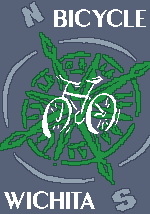Often, proposals for adding streets and widening already-existing streets include the argument that they are needed to alleviate congestion. Perhaps, though, just perhaps, other means exist by which we can ease congestion:
 "Bicycle - 90 sq. m for 71 people to park their bikes; Car - 1000 sq. m for 72 people to park their care (avg. occupancy of 1.2 people per car); Bus - 30 sq m for the bus." Click on image to enlarge. Image found here.
"Bicycle - 90 sq. m for 71 people to park their bikes; Car - 1000 sq. m for 72 people to park their care (avg. occupancy of 1.2 people per car); Bus - 30 sq m for the bus." Click on image to enlarge. Image found here.The above picture makes the case more eloquently than any number of words I can offer here, but I'll try anyway: so long as the single-occupant automobile remains the default setting for city planning--by which I mean not only street-building but other things such as zoning ordinances requiring businesses to provide a certain number of parking spaces to accommodate customers--cities will not alleviate congestion but only perpetuate it and even drive it (no pun intended) to other streets as drivers, no fools, seek and find faster (because less-congested) routes and those routes become congested. But imagine streets designed or retrofitted to accommodate and encourage alternate means of getting around, and/or augmentations of public transit in the form of more routes and more service along those routes. Not all those 72 people would take the bus or ride their bikes instead of drive their cars, no; but if even, say, seven of them were to do so on a regular basis, streets would become 10% less congested. Multiply that by the population of a city and . . .
As I noted in my previous post, bike-commuting in Wichita already appears to be increased compared to last year, but not because of anything the city has done to facilitate on-street cycling, the new bike paths and the bike lanes on Mt. Vernon notwithstanding. External circumstances--the cost of gas or other, more dire economic realities; concern for the environment; etc.--are nudging people into making that choice. At the same time, most of us know or have actually been told by others that they would like to commute by bicycle if the city's streets were more conducive to doing so. To my mind, the city could, with a few strokes of a paintbrush, simultaneously encourage these folks to leave their cars at home on occasion and save millions on expensive street-widening projects by re-striping a few well-selected streets (preferably east-west streets and some streets west of Sedgwick County park) to incorporate bike lanes. Obviously, such projects would directly benefit those already cycling on the streets and those interested in giving cycling a try. But, as the picture above makes clear, by thus reducing the number of cars taking up space on the roads, these projects would also not-so-indirectly benefit even those who choose never to cycle on the street by alleviating congestion--and that would in the long run save the city money by reducing wear and tear on streets that require repair and, further on down the road, forestalling the need to increase a street's car-carrying capacity.
Another way of saying all this: cyclists interested in making the case for bike-friendlier cities make their cases weaker if they stick only to some version of the "cyclists are people, too" argument. While that argument is certainly true, I think it's actually easier and more persuasive to demonstrate how providing on-street infrastructure that accommodates cyclists and promoting public transit ends up benefiting everyone who uses city streets, even (especially?) those who never ride a bike or take the bus. The proof of this is as plain as the picture at the top of this post.















1 comment:
Check out the webinar next week sponsored by WAMPO...http://wampoks.org/
Post a Comment